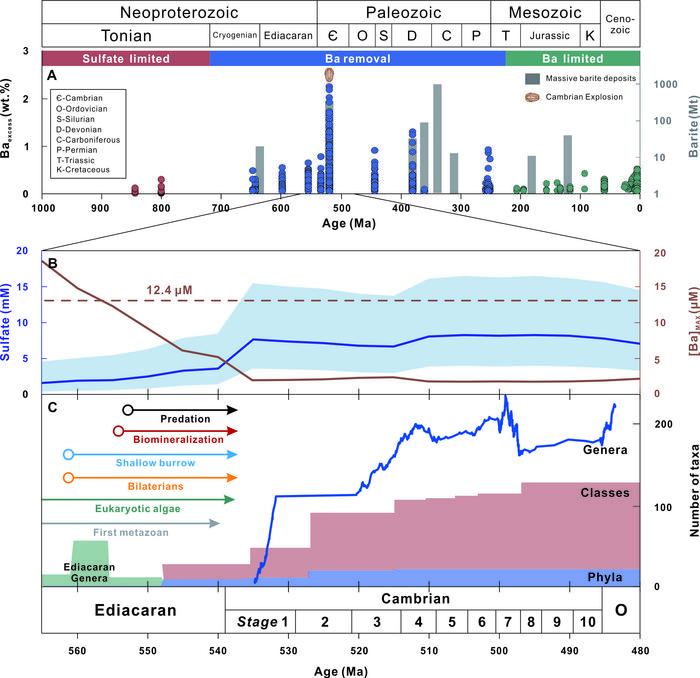This study is led by Dr. Wei Wei, PhD student Lin-Hui Dong, and Prof. Fang Huang at the University of Science and Technology of China. Excess barium contents (Baexcess) and isotope compositions (δ138Baexcess) were analyzed by Lin-Hui Dong at the State Key Laboratory of lithospheric and Environmental Coevolution. She noticed that there is a negative logarithmic correlation between the Baexcess and δ138Baexcess values. Such a relationship indicates a Rayleigh-type fractionation associated with Ba removal from a protected basin of the Yangtze Block.

Credit: ©Science China Press
This study is led by Dr. Wei Wei, PhD student Lin-Hui Dong, and Prof. Fang Huang at the University of Science and Technology of China. Excess barium contents (Baexcess) and isotope compositions (δ138Baexcess) were analyzed by Lin-Hui Dong at the State Key Laboratory of lithospheric and Environmental Coevolution. She noticed that there is a negative logarithmic correlation between the Baexcess and δ138Baexcess values. Such a relationship indicates a Rayleigh-type fractionation associated with Ba removal from a protected basin of the Yangtze Block.
The correlation between ln(Baexcess) and δ138Baexcess yields an isotope fractionation of –0.22 ± 0.03‰, well consistent with the equilibrium fractionation between the barite and fluid from first-principle calculations (–0.23 ± 0.04‰). “Enhanced barite precipitation and subsequent sedimentation were responsible for the Ba enrichments in the lower Cambrian metalliferous black shales”, Lin-Hui says.
Barite precipitation in the marine system requires a nexus of Ba- and sulfate-bearing solutions. A replete and homogeneous Ba reservoir that should be isotopically light, might have existed in the predominantly anoxic to euxinic protected basin during the Ediacaran and the earliest Cambrian. The sulfate source may have come from the upwelling of sulfate-sufficient deep seawater. As the upwelled seawater migrated onshore toward the northwest of the basin, both sulfate and Ba concentrations decreased while the δ138Ba value increased progressively due to Rayleigh-type distillation related to barite precipitation. “The spatial patterns of the Baexcess and δ138Baexcess suggest the deep-ocean oxygenation at ca. 521 Ma”, Wei Wei says.
A sensitivity analysis reveals that the majority (>99%) of the replete and homogeneous Ba reservoir in the protected basin had been scavenged at ca. 521 Ma. Such Ba removal should not be restricted to the protected basin of the Yangtze Block during the early Cambrian. From the late Ediacaran to early Cambrian, the progressive oxygenation of deep oceans, could have increased the sulfate reservoir via oxidation of sulfide and concurrently decreased the Ba reservoir by barite precipitation. Coincidently, animal diversity rapidly increased and genus-level diversity reached the first peak at the onset of the Cambrian Stage 3. Soluble Ba compounds are toxic to marine animals. “It is plausible that the removal of toxic Ba and H2S corresponding to marine oxygenation may have ultimately expanded the habitable area and paved the road for further radiation of early animals”, Fang Huang says.
See the article:
Seawater barium removal improved marine habitability for Cambrian Explosion of early animals
Journal
National Science Review



